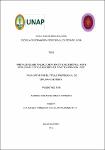| dc.contributor.advisor | Sologuren Anchante, Rafael Fernando | |
| dc.contributor.author | Ramirez Rengifo, Andrea Fernanda | |
| dc.date.accessioned | 2019-12-06T13:39:06Z | |
| dc.date.available | 2019-12-06T13:39:06Z | |
| dc.date.issued | 2019 | |
| dc.identifier.other | 617.643 R21 2019 | |
| dc.identifier.uri | http://repositorio.unapiquitos.edu.pe/handle/20.500.12737/6550 | |
| dc.description.abstract | El propósito del presente trabajo de investigación fue determinar la
prevalencia de mal oclusión según marco dental: ODI y APDI, en pacientes
atendidos en práctica privada – 2018. El método que se empleó en la
presente investigación fue de tipo cuantitativa, el diseño fue no experimental,
descriptivo simple, transversal.
La población estuvo conformada por 64 radiografías laterales de ambos
sexos, jóvenes y adultos, antes del tratamiento ortodóntico respectivo, que
fueron atendidos en consulta privada; las mencionadas radiografías fueron
sometidas al análisis cefalométrico de Kim o Marco Dental.
Los resultados más importantes fueron:
De la muestra, el 46,9% indicó mordida abierta, el 32,8% mordida normal y
el 20,3% mordida profunda, por otro lado, según el patrón esquelético, el
67,2% fue clase III, el 20,3% fue clase I y el 12,5% fue clase II según el
cefalograma marco dental; además en la investigación, la edad promedio fue
20.16 + 3,79; el ODI de la muestra fue 72,95 + 8,41; el APDI fue 91,20 +
11,33.
En relación entre el tipo de mordida y el patrón esquelético, no existe
relación entre estos (p=0,962); por otro lado, con relación entre el sexo y el
tipo de mordida, la presentes investigación concluye que no existe relación
entre sexo y tipo de mordida (p=0,871). Lo mismo pasa con relación entre el
sexo y patrón esquelético, donde la investigación concluye que no existe
relación entre sexo y patrón esquelético (p=0,088).
Con relación entre edad, Tipo de mordida y Patrón esquelético, la presente
investigación concluye que no existe relación entre edad y patrón esquelético
(p=0,388); no existe relación entre edad y tipo de mordida (p=0,075). | es_PE |
| dc.description.abstract | The purpose of this research work was to determine the prevalence of bad
occlusions according to dental framework: ODI and APDI in patients treated
in private practice - 2018. The method used in this research was quantitative,
the design was nonexperimental, simple descriptive, transversal.
The population consisted of 65 lateral radiographs of both sexes, youth and
adults, before the respective orthodontic treatment, which were attended in
private consultation; The mentioned radiographs were submitted to the
cephalometric analysis of Kim or Dental Frame.
The most important results were:
Of the sample, 46.9% indicated open bite, 32.8% normal bite and 20.3%
deep bite, on the other hand, according to the skeletal pattern, 67.2% was
class III, 20, 3% was class I and 12.5% was class II according to the dental
framework cephalogram; also in the investigation, the average age was 20.16
+ 3.79; the ODI of the sample was 72.95 + 8.41; The APDI was 91.20 +
11.33.
In relation between the type of bite and the skeletal pattern, there is no
relationship between them (p = 0.962); On the other hand, in relation to sex
and type of bite, the present investigation concludes that there is no
relationship between sex and type of bite (p = 0.871). The same applies to
the relationship between sex and skeletal pattern, where the research
concludes that there is no relationship between sex and skeletal pattern (p =
0.088).
With regard to age, type of bite and skeletal pattern, the present investigation
concludes that there is no relationship between age and skeletal pattern (p =
0.388); There is no relationship between age and type of bite (p = 0.075). | en_US |
| dc.description.uri | Tesis | es_PE |
| dc.format | application/pdf | es_PE |
| dc.language.iso | spa | es_PE |
| dc.publisher | Universidad Nacional de la Amazonía Peruana | es_PE |
| dc.rights | info:eu-repo/semantics/openAccess | es_PE |
| dc.rights | Attribution-NonCommercial-NoDerivs 3.0 United States | * |
| dc.rights.uri | http://creativecommons.org/licenses/by-nc-nd/3.0/us/ | * |
| dc.source | Universidad Nacional de la Amazonía Peruana | es_PE |
| dc.source | Repositorio institucional - UNAP | es_PE |
| dc.subject | Maloclusión | es_PE |
| dc.subject | Prevalencia | es_PE |
| dc.subject | Radiografía Dental | es_PE |
| dc.subject | Práctica Privada | es_PE |
| dc.title | Prevalencia de maloclusión según marco dental: ODI y APDI, en pacientes atendidos en práctica privada - 2018 | es_PE |
| dc.type | info:eu-repo/semantics/bachelorThesis | es_PE |
| thesis.degree.discipline | Odontología | es_PE |
| thesis.degree.grantor | Universidad Nacional de la Amazonía Peruana. Facultad de Odontología | es_PE |
| thesis.degree.level | Título Profesional | es_PE |
| thesis.degree.name | Cirujano Dentista | es_PE |
| thesis.degree.program | Presencial | es_PE |
| dc.subject.ocde | http://purl.org/pe-repo/ocde/ford#3.02.14 | es_PE |


